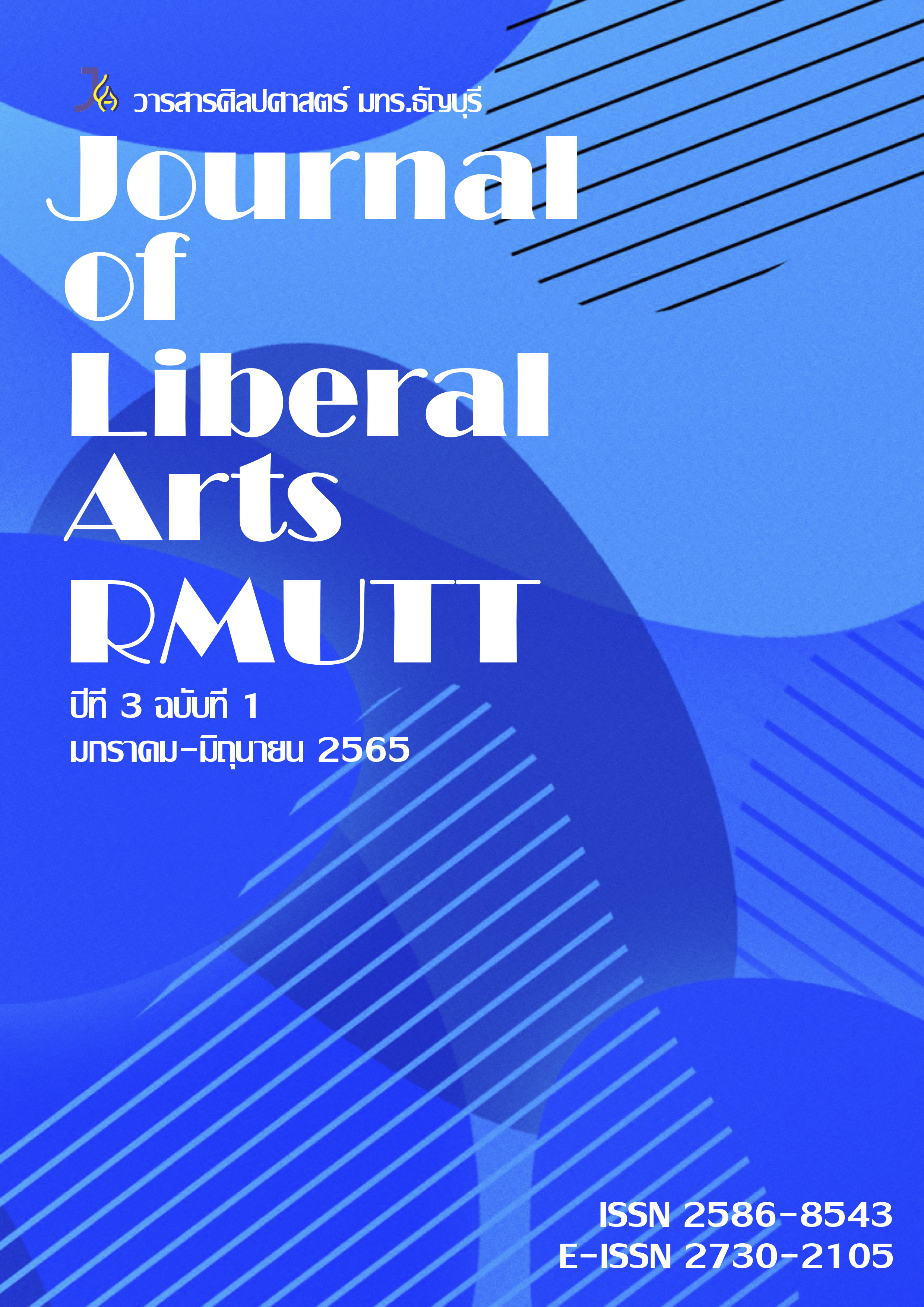‘I use active learning, but my class is not always active’ Secondary School English Teachers’ Perceptions of Active Learning
คำสำคัญ:
ความเข้าใจ, การประยุกต์ใช้ , การจัดการเรียนการสอนแบบ active learningบทคัดย่อ
บทคัดย่อ
Active learning เป็นรูปแบบการเรียนรู้ที่มีประสิทธิภาพ เป็นที่ยอมรับ และถูกนำไปใช้โดยแพร่หลายทั่วโลก งานวิจัยชิ้นนี้มุ่งเน้นที่จะศึกษาเกี่ยวกับความเข้าใจของครูผู้สอนในรายวิชาภาษาอังกฤษระดับมัธยมศึกษาและการประยุกต์ใช้ active learning ในบริบทของตัวครูผู้สอนเอง กลุ่มตัวอย่างได้แก่ ครูผู้สอนในรายวิชาภาษาอังกฤษระดับมัธยมศึกษาในภาคตะวันออกเฉียงเหนือ จำนวน 10 ท่าน ซึ่งระบุคุณสมบัติไว้ในสำรวจว่ามีความคุ้นเคยกับ active learning รวมทั้งมีความประสงค์ที่จะให้ความร่วมมือในการวิจัย โดยผู้วิจัยได้ทำการสัมภาษณ์กลุ่มตัวอย่างเพื่อเก็บข้อมูลเชิงลึกเกี่ยวกับ active learning รวมทั้งมุมมองต่าง ๆ และการประยุกต์ใช้อีกด้วย ข้อมูลจากการสัมภาษณ์ได้ถูกนำมาวิเคราะห์เพื่อจัดหมวดหมู่ตามสาระ ก่อนจะนำมาเสนอและอภิปราย ผลการวิจัยพบว่ารูปแบบการตีความและความเข้าใจของครูผู้สอนที่มีต่อ active learning มีทั้งความคล้ายคลึงและความแตกต่าง โดยส่วนมากมองว่า active learning นั้นครอบคลุมทั้งเชิงกายภาพและด้างองค์ความรู้ของรูปแบบการเรียนรู้ ซึ่งไม่สามารถสังเกตได้ในบริบททั่วไป นอกจากนั้น ครูผู้สอนยังให้ความเห็นว่าการเรียนการสอนในชั้นเรียนจริงนั้นไม่สามารถทำให้ active ได้ตลอด ข้อมูลเกี่ยวกับความเข้าใจและการประยุกต์ใช้ active learning ของครูผู้สอนนั้น แสดงให้เห็นถึงความซับซ้อน และรูปแบบที่หลากหลายของตัวนิยามดังกล่าว ซึ่งจำเป็นต้องใช้ความใส่ใจทั้งจากครูผู้สอนและจากชุมชนวิชาชีพครูด้วยเช่นกัน
คำสำคัญ: ความเข้าใจ / การประยุกต์ใช้ / active learning
เอกสารอ้างอิง
Allen, D.E., & Tanner, K.D. (2003). Learning in context: problem-based learning. Cell Biol. Educ., 2, 73–81.
Allsop, J., Young, S. J., Nelson, E. J., Piatt, J., & Knapp, D. (2020). Examining the Benefits Associated with
Implementing an Active Learning Classroom among Undergraduate Students. International
Journal of Teaching and Learning in Higher Education, 32 (3), 418-426.
Bonwell, C.C., & Eison,J. A. (1991). Active learning: Creating excitement in the classroom. ASHE-Eric
Higher Education Report No. 1. Washington, DC.: George Washington University.
Bonwell, C., & Sutherland, T. E. (1996). The active learning continuum: Choosing activities to engage
students in the classroom. New Directions for Teaching and Learning, 1996(67), 3-16.
Carson, R. N. (1995). Active Learning. Montana: Montana State University.
Crews T. B., Ducate L., Rathel J. M., Heid K., & Bishoff S. T. (2011). Clickers in the classroom: Transforming
students into active learners. Retrieved on Jan 31, 2022, from https://its.unl.edu/pdfs/
Educause%20SRS%20success.pdf
Drew, V., & Mackie, L. (2011). Extending the constructs of active learning: Implications for teachers’ pedagogy and practice. Curric. J. 22, 451–467.
Fern, V., Anstrom, K., & Silox, B. (1993). Active Learning and the Limited English Proficient Student.
Bethesda MD: National Clearing House for Bilingual Education.
Leu, E., & Price-Rom, A. (2006). Quality of education and teacher learning: A review of the literature.
McKinney, K. (2007). Enhancing learning through the scholarship of teaching and learning: The
Challenges and the joys of juggling. San Francisco: CA: Anker.
Nata, N. & Tungsirivat, K. (2017). Active learning for language skills development. International (Humanities,
Social Sciences and Arts), 10(5), 506-515.
the Office of the Basic Education Commission. (2020). OBEC Policy of 2020. Retrieved on November 24,
, from http://www.bopp.go.th/?cat=25#
Page, M. (1990). Active learning: Historical and contemporary perspectives. Amherst, MA: University of
Massachusetts.
Petersen, C. I. & Gorman, K. S. (2014). Strategies to Address Common Challenges When Teaching in an
Active Learning Classroom. New Directions for Teaching and Learning, 137, 63-70.
Prince, M.J., & Felder, R.M. (2006). Inductive teaching and learning methods: Definitions, comparisons, and
research bases. J. Eng. Educ. 95, 123–138.
Rimm-Kaufman, S., Baroody, A., Larsen, R., Curby, T., & Abry, T. (2015). To What Extent Do Teacher-Student
Interaction Quality and Student Gender Contribute to Fifth Graders' Engagement in Mathematics
Learning?. Journal of Educational Psychology, 107, 170-185.
Scheyvens, A., Amy, L., & Griffin, B. (2008). Experimenting with active learning in geography: Dispelling the
myths that perpetuate resistance. Journal Geography in Higher Education, 32(1), 51-69.
Trowler, V. (2010). Students Engagement Literature Review. York: The Higher Education Academy.
Wimpenny, K. & Savin-Baden, M. (2013). Alienation, agency and authenticity: A synthesis of the literature
on student engagement. Teaching in Higher Education. 18(10), 1080.
Youpensuk, N. & Laiprasertporn, N. (2018). The usage of P.I.L. active learning model on body organ system
of grade 6 science class of demonstration school. In The 2020 International Academic Multidiscipline Research Conference in Lucerne, pp. 142-149. Bangkok: Suan Sunandha Rajabhat University, Thailand.
Yuusuk, S. (2020). An Implementation of Active Learning in Thai University Students’ English Language
Classroom. Journal of Liberal Arts, Maejo University, 9 (1), 112-135.
ดาวน์โหลด
เผยแพร่แล้ว
รูปแบบการอ้างอิง
ฉบับ
ประเภทบทความ
สัญญาอนุญาต
ลิขสิทธิ์ (c) 2022 วารสารศิลปศาสตร์ มทร.ธัญบุรี

อนุญาตภายใต้เงื่อนไข Creative Commons Attribution-NonCommercial-NoDerivatives 4.0 International License.









